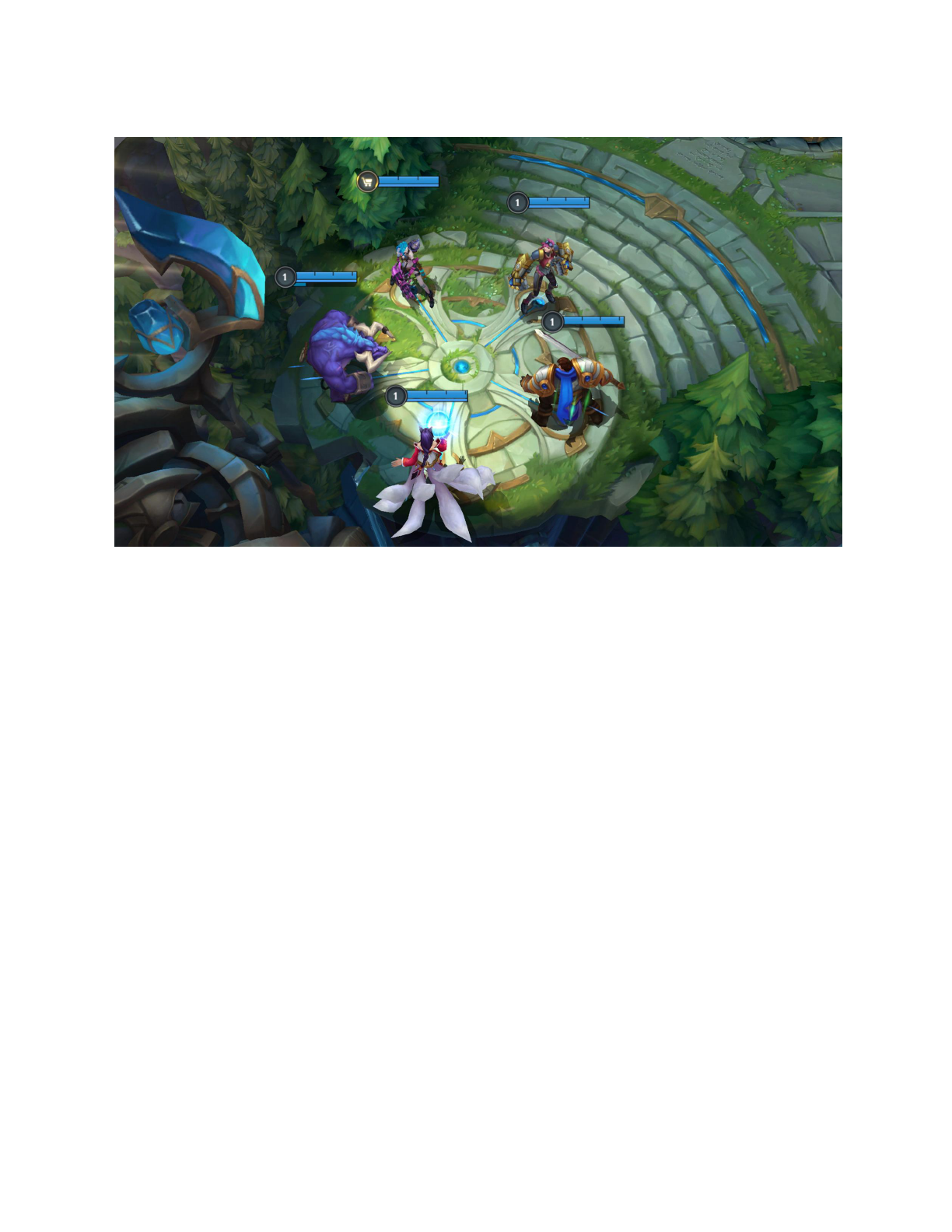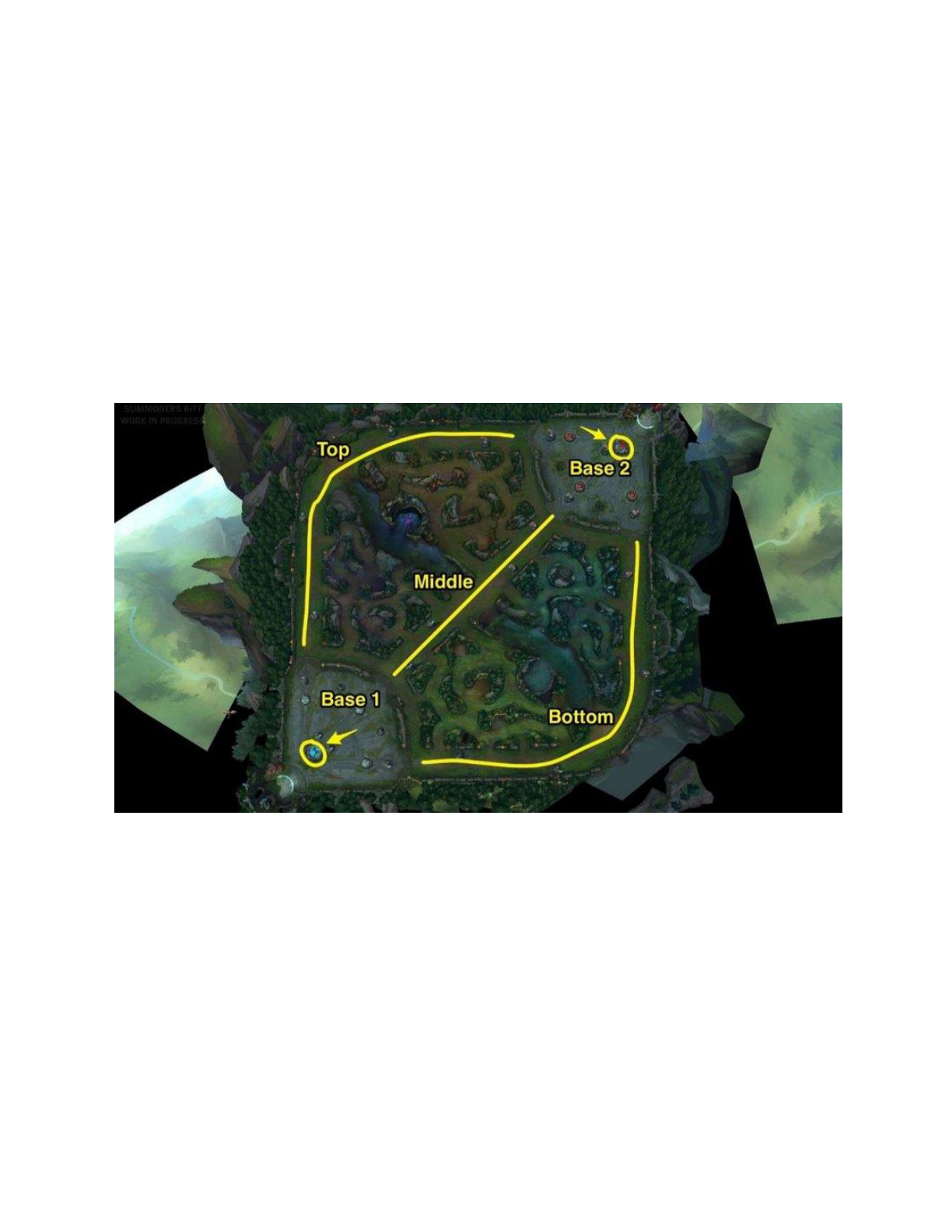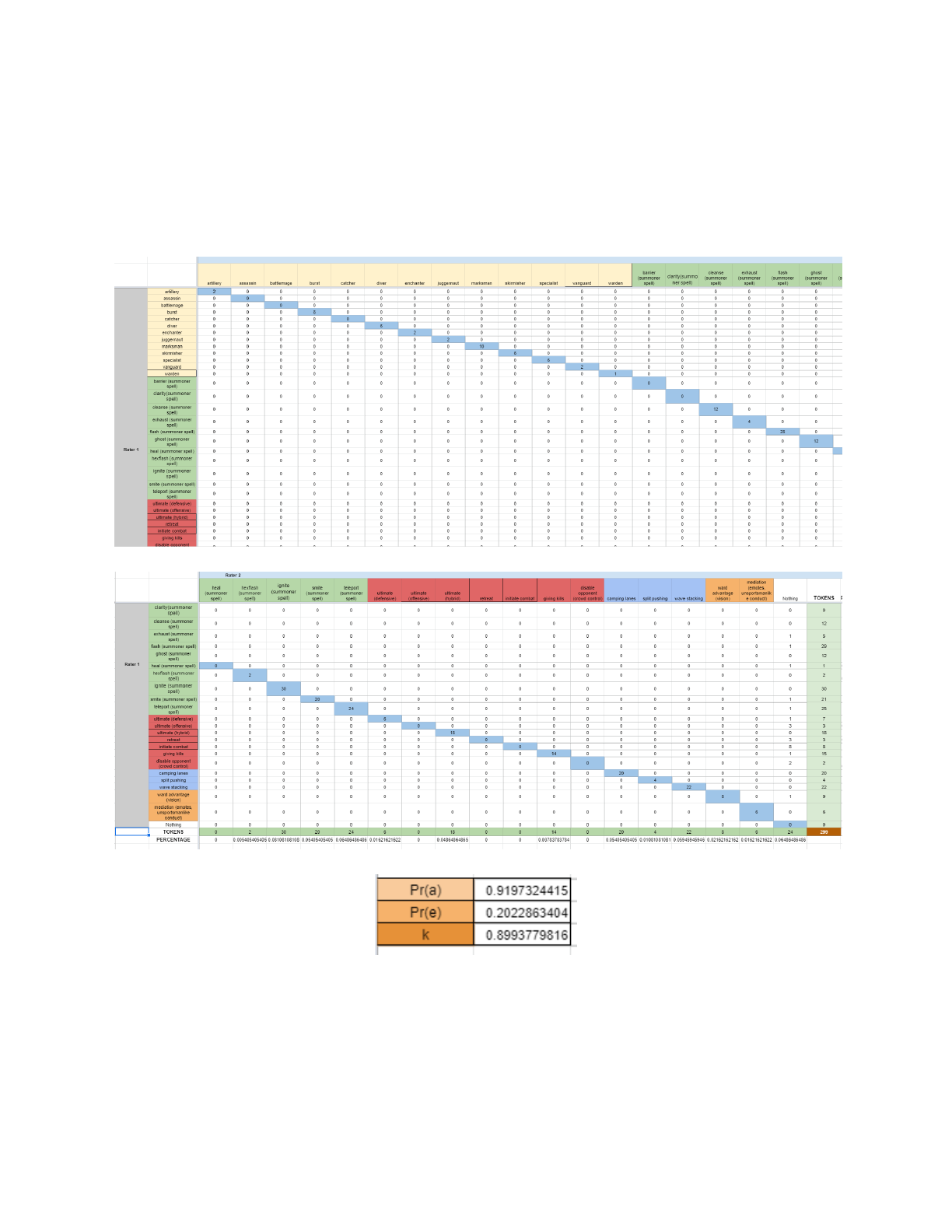
1
Identifying Strategies of Esports Players at
Various Proficiency: The case of League of
Legends
Thesis Presented by Lawrence Edmondson
to the Department of Art + Design
In Partial Fulfillment of the Requirements for the Degree of Master of Science in Game Science
and Design in the Graduate School of the College of Arts, Media and Design
Northeastern University
Boston, Massachusetts
May, 2021

2
Abstract
Developing effective strategies in esports is paramount for top tier playing. However,
despite being core to gaming proficiency, strategy development for competitive gaming has been
under represented in esports research. Here, I look at strategy development in esports by
considering the specific case of League of Legends (LoL). Specifically, I identify strategies used
by LoL players at various degrees of proficiency (i.e., from top tier to low tier) by analyzing 20
YouTube videos of professional LoL tournaments and regular ladder games. Through content
and thematic analysis, I identify multiple strategies in LoL that include (1) team composition
(hero selection for each team), (2) summoner spells used, (3) champion abilities, and
systematically analyze how they are used by competitive gamers, as well as the techniques used
to deploy these strategies (e.g., wave clearing or split pushing). Results from the analysis show

3
that players tend to play more aggressive and look to make more offensive plays versus playing
defensive. I conclude by discussing what implications these results have in advancing the
scientific understanding of phenomena related to esports.
Introduction
Electronic sports (i.e., esports) originated in 1980 in the form of arcade video gaming
(Tang, 2020). Because of the growth and evolution of the internet, which in turn has contributed
to the growth and evolution of gaming, esports have become key to gaming culture. In 2016, the
industry accumulated more than 30 billion in revenue, and was expected to bring in 1.5 billion
dollars by 2020 (Wallner, 2019, pp. 1–3). Starting from 2024, esports will be part of the
Olympics. Their notoriety, increasing media exposure, and annual revenue, are beginning to
increase the esports overall consideration by both the media, industry, academia, and elevating
them to the rank of “actual” sports (for a discussion, see Kane et al., 2017).
Hence, we can consider esports like any other professional sport, where developing
strategy and game-planning are key to effective performances and increase chances of winning.
However, despite the increasing interest of academic research around esports (for a review, see
Reitman et al., 2019) the way in which players develop strategies in esports is yet undervalued
and lacks systematic analyses. Here, I consider the case of League of Legends (LoL), a
multiplayer online battle arena game (MOBA) created by Riot Games back in 2009, and explore
how players of different ranking and proficiency develop strategy in their games (see Tang,
2020; Harteveld et al., 2019).

4
Specifically, I analyze 20 YouTube videos from professional players playing tournament
games of LOL to high ranking ladder games in the solo queue (the normal ladder where
everyone plays) and extrapolate game play strategies by systematically identifying individual
instances of LOL strategy archetypes (e.g., wave stacking, split pushing). This thesis advances
the scientific understanding of how players develop strategies in esports (here LoL) and its
results will be useful to both esports researchers and trainers. I conclude by discussing what these
results mean to esports and possible applications/directions in future work.
Background
League of Legends (aka LoL)

5
Figure 1.
League of Legends (LoL) is a multiplayer online battle arena game (MOBA) created by Riot
Games in 2009 (Figure 1). The game scope is simple: two teams of five compete against each
other with the goal of destroying the opposing team’s nexus (the heart of your team's base. When
the nexus is destroyed, the game is over). Since its creation, there have been a total of
approximately 64 million people playing the game worldwide and making it one of the most
successful online video games ever (Ramler et al., 2017). The most recent international
tournament of LoL has seen more than one billion hours watched in total (LoLEsportsStaff,
2020), proving the high popularity of this game in esports. LoL has a large competitive scene.
The higher the rank, the more skilled the players will be, and the more refined their strategies

6
and tactics will be. Recent academic work around LoL has investigated problematic discourses
of toxicity or emotion regulations of players (Kou et al., 2020a; 2020b). Here, I continue
research efforts around esports and LoL by exploring how players develop strategy and tactics in
this game at competitive levels. Next, I briefly overview the game mechanics of LoL.
LoL Game Mechanics
Figure 2.
As said above, the scope of LoL is for two teams to compete against each other and
destroy their respective nexus’. There are two teams consisting of five heroes that are all
controlled by human players. Each hero is different from another and possesses their own
“special” abilities, stats, and lore. Both teams play their game inside a map, which is square and
split diagonally in the middle into two sides in a symmetric fashion; each team owns one side.

7
This map, which is also known as the “summoner’s rift” (Figure 2), has three lanes: (1) mid, (2)
top, and (3) bottom. Artificial intelligence bots, aka “creeps”, spawn at each team’s nexus and
walk down each lane until reaching the other team’s nexus and (eventually) destroy it. If they
come along an enemy force on the way, they will engage in combat. The goal of the players is to
help push their team into the other base and destroy the nexus with the help of their own creeps.
Related work
Researchers have explored patterns of combat, metagame strategies, tactical awareness vs
operational skills, and team proficiency. Patterns in combat were presented in a data-driven
method which led to successful game outcomes (Yang et al., 2019). Lee & Ramler use a python
script to identify several non-meta strategies that show a consistent advantage over the meta. Xia
et al. uses evaluation indicators for testing gameplay to conclude that tactical awareness affects
the multiplayer killing indicator and the game result more so than operational skills. Team
composition was broken down by Kim et al. and we find out that player proficiency increases
team performance more than team congruency. I add to previous work by supplying data on how
players conceive different strategies as well as supplying data on the strategies that are being
conceived. My thesis is a mix of all of this research. I cover the metagame, combat tactics, and
team composition.

8
Methodology
Participants
League of legends has 9 ranks: iron, bronze, silver, gold, platinum, diamond, master,
grandmaster, and challenger. For my study I analyzed 20 games that only consisted of players
residing in the top 4 ranks which were diamond, master, grandmaster, and challenger (in order
from lowest to highest). Pro LoL players are technically challenger rank, but professional players
are normally required to be in the top 50 of challenger or higher for a long period of time. In
2019, there were roughly one thousand pro players. This meant that roughly 1 out of every
100,000 players would go pro. That is less than a 1% chance (Stuart, 2021).
All of the games I used can be found on YouTube. I analyzed games from Vapora Dark,
the Challenger replays youtube channel, and games from the 2020 worlds. Vapora Dark is a high
ranking player who has consistently achieved masters rank since 2015. Challenger Replays is a
youtube channel that provides League of Legends replays from players ranked Master through
challenger. The 2020 worlds was the championship series where teams from all of the
professional leagues across the world come together to see who is the best team in the world.
Design
I will be using the 4 levels of war, as recognized by the military, as the foundation of my
thesis. There are 4 levels of war: tactical, operational, strategic, and political. For the sake of
confusing name mix-ups, I am going to refer to the strategic level of war as the logistic level of
war. Each of these levels has their own important function in terms of winning a war; ranging

9
from the actual decision making and weapons used on the battlefield all the way to relationships
between allies and psychological warfare. I translated those 4 levels of war into a system aligned
with LoL.
Tactical strategy refers to success in battle due to engagements through decision and
actions that create advantages. Tactical strategy includes weapon systems used, potential combat
power, and the achievement of goals on an operational level. In League of Legends this translates
to how well you can operate and control your champion in-game on the battlefield.
Operational strategy is the middle ground found between action and thought that focuses
on design and organization through campaigns (a plan). Operational strategy is more about
designing a plan to conquer a larger objective. In league of Legends this refers to a focus on team
cooperation and chemistry. Operational planning can consist of plays such as team rotations,
wave management, establishing or denying vision, and lane pressure.
Logistical strategy refers to plans that aim for obtaining objectives and coming up with
game plans before the battle starts. It can be confused with operational strategy because it is
closely aligned with campaigns, but logistical strategy is on a higher level. Logistical strategy is
the entire game plan of how you plan on winning the war. This translates to League of Legends
in the sense of champion itemization, pre-game preparation (runes and masteries), team
composition, etc.
Political strategy refers to your relationship with allies, societal issues, national will, etc.
this translates to the mental exploitation/ psychological warfare in League of Legends. Anything
that has a correlation to mental warfare falls under the political level: camping lanes (usually
performed by jungler), communication with the opposing team in-game (or before), giving kills
to your teammates to help them snowball, etc.

10
Procedure
For my research I will be doing content and thematic analysis (Neuendorf, K. A., &
Kumar, A. (2015). Content analysis. The international encyclopedia of political communication,
1-10.). I will be observing League of Legends games on YouTube and analyzing them for
strategies and tactics. I will create a coding system using the 4 levels of war that recognizes these
strategies and tactics. Then I will be using Cohen’s Kappa to assess the reliability of my scoring.
My coding scheme can be found here.
One limitation I faced was the type of analysis I was doing. Thematic analysis can take a
long time especially in these games where you have to pay attention to every summoner spell
and ultimate used so that you don't miss any. It was also hard to document everything every
player did ex: dropping vision wards. Professional games have a roaming camera view that
automatically moves to action activity. This made those games easier to score because the
camera was not locked. Non-professional games have a camera view that locks on to one player
for the whole game, so it's hard to see what other players are doing. Some champions also have
ultimates that do not act like normal ultimates making them hard to code because those ultimates
can skew the scoring system.
Scoring
Games were scored using the 4 types of strategy: tactical, operational, logistic, and
political. Inside of these categories there are multiple different taxonomies that were scored:

11
● Summoner spells (barrier, clarity, cleanse, exhaust, flash, ghost, heal, hexflash, ignite,
smite/chilling smite/challenging smite, & teleport): a point was scored for each of these
summoner spells whenever they were activated.
● Defensive ultimate ability: A defensive ultimate would be scored when a player uses
their ultimate while they are retreating, in order to retreat, or to stop the opposing team
from doing something.
● Offensive ultimate ability: An offensive ultimate ability would be scored when a player
uses their ultimate in order to engage an enemy.
● Hybrid ultimate ability: A hybrid ultimate ability would be scored when a player uses
an ultimate outside of battle entirely. An example of this could be if a player uses an
ability to scout for vision or using an ability against a creep (battling is strictly meant for
PvP fights).
● Retreating: Retreating would be scored when a player attempts to flee from a fight.
● Initiate combat: Initiating combat would be scored when one player attacks another with
a 5 second grace period in between each initiation.
● Disable opponent: Disabling an opponent would be scored whenever a player is crowd
controlled (CC’d). When a player is CC’d it will appear over their head and say either:
stunned, airborne, blind, cripple, disarm, disrupt, drowsy, sleep, charmed, flee, taunt,
ground, kinematics, root, silence, polymorph, slow, stasis, stun, suspension, or
suppression.
● Camping lanes: Camping lanes would be scored when any player is unseen by a player
who is in one of the three lanes, and attacks them from the jungle or any route that is not
from the lane directly in front of them.

12
● Split pushing: Split pushing would be scored when a player moves to a weaker or
undefended lane and applies pressure by pushing the lane in an attempt to gain a tower
advantage while the rest of his team is all together. This is normally executed in mid-late
game.
● Wave stacking: the process of letting your creep wave build up by eliminating a number
of creeps from the opposing creep wave so that your creep wave ultimately does more
damage per second. Eventually your creep wave will begin to stack and push the
opposing creep wave back and back until the creep waves are balanced. Wave stacking
would be scored when a player kills more opposing creeps than how many are on his side
(this also applies when a player kills an entire enemy creep wave).
● Vision Advantage: Placing wards on your side of the map for visibility. Wards make it so
that you can see places on the map that might serve as gank lanes for you or your enemy.
Wards grant visibility and visibility wins games. Ward advantage would be scored when a
player uses an oracle lens and sweeps the area destroying any enemy wards that might be
nearby acquiring vision advantage.
● Team composition: This was scored by tallying one mark for each champion archetype
playing in the game. There are thirteen archetypes: enchanter, catcher, juggernaut, diver,
burst, battlemage, artillery, marksman, assassin, skirmisher, vanguard, warden, and
specialist.
● Mediation: Mediation would be scored when any emotes are displayed or any
unsportsman-like conduct takes place.

13
Results
Cohens Kappa results
Figure 3.

14
I used the 4 levels of war as a foundation to recognize different strategies and tactics in
LoL. An inter-rater reliability analysis was performed using Cohen’s Kappa statistic to determine
consistency among raters. The inter-rater reliability for the raters on the Strategy spreadsheet was
found to be Kappa = 0.89 (p < 0.01). This means that both the rater and I came out with very
similar results in our scoring totals. My research has shown that initiating combat, using
champion ultimates offensively, and flash were the three most scored categories. This shows that
players are inherently aggressive and are constantly looking to make plays on the rift. Although
ultimates could be used defensively, offensive ultimates were used a lot more. Flash was used
offensively just as much as it was used defensively. Offensively, flash was used many times in
attempts at making a play (an attempt to gain an advantage on the rift by landing a kill, helping
your teammate land a kill, or by disrupting your opponent). Teleport was the second most used
summoner spell and that is for good reason. The ability to instantly teleport to any place on the
map is a powerful tool in war. Teleport is so important because it allows the player to quickly,
and in some cases stealthily, make big plays. Retreating might not have happened as many times
as initiations, but they were present throughout the whole game, showing that smart
decision-making is still one thing that players recognize as a key to winning. Giving the enemy
team extra gold by dying while trying to force a battle that has a low chance of success is a grave
offense in LoL, and this is why retreating is so important. These were all categorized in the
tactical level of war.
On the logistical level of war, non-professional games (lower ranked ladder games) used
a broader champion pool. This seems to show that the professionals stick to a smaller meta of
champions because they are the most effective, whereas lower ranked games leave more room
for champion diversity. There were also more marksmen champions selected (3 a game) than any

15
other champion archetype in 7/20 games. This shows their importance because of their lethality.
Marksmen champions are also known as ADCs (attack damage carries), the champions who do
the most physical damage in the game, thus are usually relied on to carry the team to victory. The
second most used champion archetype were vanguard champions. Vanguard champions are tanks
and they are usually paired with a marksman champion in-game in order to protect them from
harm. For the operational level of war, wave stacking usually continued into late game. In LoL,
gold and experience equal power. The more of those two things you have, the more powerful
your champion will be. This is why wave stacking was done throughout the entirety of most
games, because the intake of gold is key to overpowering your opponent. Regarding the political
level of war, a lot more emotes were used in lower rank games. Emotes were used as a form of
communication whether they were letting a teammate know they got out of a fight safely or
taunting an opponent. In the professional games, emotes were mostly only observed at the very
end of a game once a team had destroyed the other team’s nexus.
Discussion
LoL is a real-time strategy game where tactics are the main focus in winning. My
research shows that players tend to play more aggressively versus conservatively. Player
attitude’s are geared towards always looking to make a play and being offensively minded. These
behaviors are aligned with the nature of the game because LoL is meant to be a skirmishing
game between 2 teams. Even the most used summoner spells (flash and teleport) have an
important impact on playmaking which is attributed to offense. Retreating wasn't observed as

16
many times as its offensive counterparts, but it was close behind showing that even in an
offensive-oriented game smart decision making is still as important as playing aggressively.
Xia et al. uses the mood method to show that teams with more kills by one player,
multiple players, and fights initiated show that they have a higher chance of winning. My work
supports this finding because my research shows that initiating fights are one of the most
common forms of tactical warfare in LoL and playing aggressive leads to making plays which
leads to obtaining kills.
The ADC role along with the middle role receive the most assists from their teammates
(Mejorado & Marquez, 2019). This is an assist on a kill which means one player does damage to
another player but is not the one who ends up killing that player. This aligns with my studies
because my research showed ADC champions were the most selected champion archetype
because of their lethality. This translates to them racking up assists in battle because they can do
a lot of damage to champions fast.
Conclusion
By looking at strategy development in LoL through the 4 levels of war, my research has
shown that LoL is an offensive-oriented game. The strategies observed suited a more aggressive
style of play while also showing how important it is to make the right decisions in-game to
mitigate your opponents advantage margin. All 4 levels of war were witnessed but none more
than the tactical level of war. Summoner spells and other tactical strategies were used as
playmaking potential. Professional players were more prone to using the same small pool of
champions versus lower rank players who were more diverse in their champion selection.

17
Champions of the marksman archetype were selected more times than any other character
archetype.
References
Tang, W. (2020, June). Understanding esports from the Perspective of Team Dynamics. The
Sport Journal.
https://thesportjournal.org/article/understanding-esports-from-the-perspective-of-team-dy
namics/
Wallner, G. (2019). Data Analytics Applications in Gaming and Entertainment (1st ed.)
[E-book]. Auerbach Publications.
https://www.google.com/books/edition/Data_Analytics_Applications_in_Gaming_an/_xa
mDwAAQBAJ?hl=en&gbpv=1&pg=PA49&printsec=frontcover
Harteveld, C., Kleinman, E., Rizzo, P., Schouten, D., Nguyen, T. H., Liberty, S., ... & El-Nasr, M.
S. (2019, August). Teamwork and adaptation in games (TAG) a survey to gauge
teamwork. In Proceedings of the 14th International Conference on the Foundations of
Digital Games (pp. 1-12).
Lee, C. S., & Ramler, I. (2017, August). Identifying and evaluating successful non-meta
strategies in league of legends. In Proceedings of the 12th International Conference on
the Foundations of Digital Games (pp. 1-6).

18
Stuart. (2021, March 17). How to Become a Pro League of Legends Player. Cyber Athletiks.
https://cyberathletiks.com/how-to-become-a-pro-league-of-legends-player/.
Michael G Wagner. 2006. On the Scientific Relevance of eSports.. In International conference on
internet computing. 437–442.
Nagorsky, E., & Wiemeyer, J. (2020). The structure of performance and training in esports.
PLOS ONE, 15(8). https://doi.org/10.1371/journal.pone.0237584
Xia, B., Wang, H., & Zhou, R. (2019). What Contributes to Success in MOBA Games? An
Empirical Study of Defense of the Ancients 2. Games and Culture, 14(5), 498–522.
https://doi.org/10.1177/1555412017710599
D. A. M. Mejorado and J. E. R. Marquez, "Visual analytics of team performance in online
gaming," 2019 IEEE International Conference on Systems, Man and Cybernetics (SMC),
2019, pp. 3025-3030, doi: 10.1109/SMC.2019.8914387.
Yang, P., Harrison, B. E., & Roberts, D. L. (2014, April). Identifying patterns in combat that are predictive of
success in MOBA games. In FDG.
